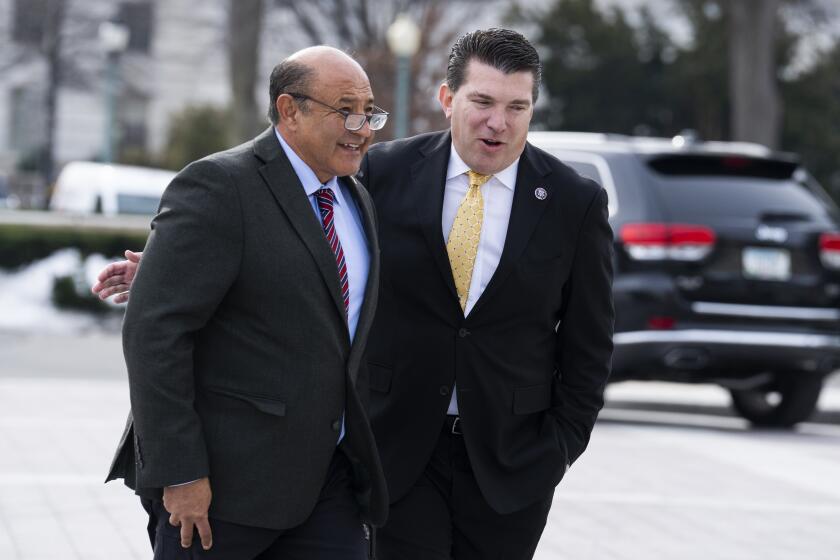This Time Around, Government Present and Accounted For
Katrina’s deadly rampage had at least one beneficial effect, disaster experts said Sunday: It ensured that government agencies took the next big storm, Hurricane Rita, very seriously.
This time, the federal government dispatched troops sooner, sent supplies earlier and coordinated more smoothly with local authorities. The consensus is that the response helped minimize the loss of life from a storm that was damaging, though less powerful than Katrina.
Though complaints continued Sunday about the need for better evacuation planning -- in the frantic exodus from Houston, there was an epic traffic jam and 23 seniors were killed in a bus fire -- even officials who criticized the federal government after Katrina were praising the reaction to Rita.
With lessons learned from both hurricanes, state and local officials stressed the need for better evacuation plans. Military commanders argued for tighter coordination. And President Bush raised the possibility of placing the Pentagon in charge of responding to the biggest natural disasters.
In a briefing for the president Sunday in San Antonio, Air Force Maj. Gen. John White, overseeing the storm area, called for development of a national disaster rescue plan to clarify the roles of the various agencies. Under the current system, five helicopters could arrive to rescue one storm victim.
“We’re not maximizing the use of our forces to the best efficiency,” White told Bush in a briefing at Randolph Air Force Base. “Certainly, that was a train wreck that we saw in New Orleans.”
Bush, who returned to Washington after visits to Texas and Louisiana, stressed again that he and Congress would be looking at whether to give the Pentagon a more prominent role in domestic disasters.
“Is there a natural disaster of a certain size that would then enable the Defense Department to become the lead agency in coordinating and leading the response effort? That’s going to be a very important consideration for Congress to think about,” Bush said, expanding on an idea raised in a speech in New Orleans this month.
R. David Paulison, acting director of the Federal Emergency Management Agency, said the early and thorough evacuations in Texas and Louisiana made all the difference.
“The coordination and smooth preparation for this hurricane has been absolutely phenomenal,” said Paulison, who was brought in after the resignation of Michael D. Brown, who was widely criticized over the federal response to Katrina.
Even Louisiana Gov. Kathleen Babineaux Blanco, a Democrat who lashed out at Bush in the Katrina aftermath, praised the president Sunday for his commitment to rebuilding her state. Louisiana politicians of all stripes took to the airwaves Sunday to urge approval of a $250-billion rebuilding plan.
Blanco met briefly with Bush when he visited Baton Rouge, the Louisiana capital.
“His concern is obvious,” said Blanco, who added that her state was reeling from the double blow of Katrina and Rita, which caused extensive flooding. “His active involvement in our relief and reconstruction efforts are much appreciated.... Certainly, we were able to get a timely response to Rita.”
Texas Gov. Rick Perry, a Republican, said the federal response ensured that his state didn’t suffer loss of life from Rita, which roared ashore early Saturday along the Louisiana border.
Perry emphasized that law enforcement officers and the National Guard had deployed in large numbers, as opposed to the situation in New Orleans, which was plagued by lawlessness in the days after Katrina. He also said his state would look into evacuation procedures.
“We’ve got the place secure. We’ve got a lot of troopers. We’ve got a lot of folks in uniform here,” said Perry, who added during an interview on NBC’s “Meet the Press” that his state had “dodged a major bullet.”
But some continued to lash out at inadequacies they saw.
Houston Mayor Bill White sharply criticized the lack of gasoline and other supplies along evacuation routes, which came to a standstill after being jammed by fleeing residents.
“Everybody knew that it was just totally unacceptable and that there was not adequate fuel supplies stashed around the state,” he told reporters.
And Jefferson County Judge Carl Griffith said he was forced to call U.S. Sen. Kay Bailey Hutchison (R-Texas) to get the federal government to focus on evacuation problems.
“It’s clear that there’s a breakdown,” he said on “Fox News Sunday.”
“The state requests the stuff, and the bureaucracy is too large in Washington, and it doesn’t get through and they don’t meet the needs of the community.”
Disaster experts agreed that evacuation problems were a sign there was still much improvement to be made in the government’s response.
For instance, they said, gasoline trucks should have been stationed along evacuation routes from Houston and Galveston, a lesson federal officials learned during Hurricane Floyd, which struck North Carolina in 1999.
Jane Bullock, FEMA chief of staff at the time and now a disaster management consultant, said officials in Texas may not have been aware of the lesson because Floyd did not strike there.
“Maybe the president has realized that response to disaster is truly a federal function when they’re large disasters,” said Bullock, who favors removing FEMA from the Department of Homeland Security and restoring it as a separate agency. “It’s not something we can just delegate to state and local governments.”
Disaster experts also noted that Rita was a much different storm: a Category 3, compared with Katrina, a Category 4 with more destructive winds. Rita stormed ashore in a relatively unpopulated area, whereas Katrina struck near New Orleans, a large city below sea level with a levee system that failed.
But experts said the furor sparked by the slow-footed federal reaction to Katrina ensured a better reaction to Rita.
“It was much more organized,” said Richard Krimm, who was the associate director for FEMA’s response and recovery team under President Clinton. “It was really done the way it should be, with involvement by the president on down.”
Albert Ashwood, incoming president for the National Emergency Management Assn., said the federal government should make sure local officials have the flexibility to tailor emergency response plans to their needs. Federal funding to plan for natural disasters now is available only for hurricanes and earthquakes.
More to Read
Start your day right
Sign up for Essential California for news, features and recommendations from the L.A. Times and beyond in your inbox six days a week.
You may occasionally receive promotional content from the Los Angeles Times.






